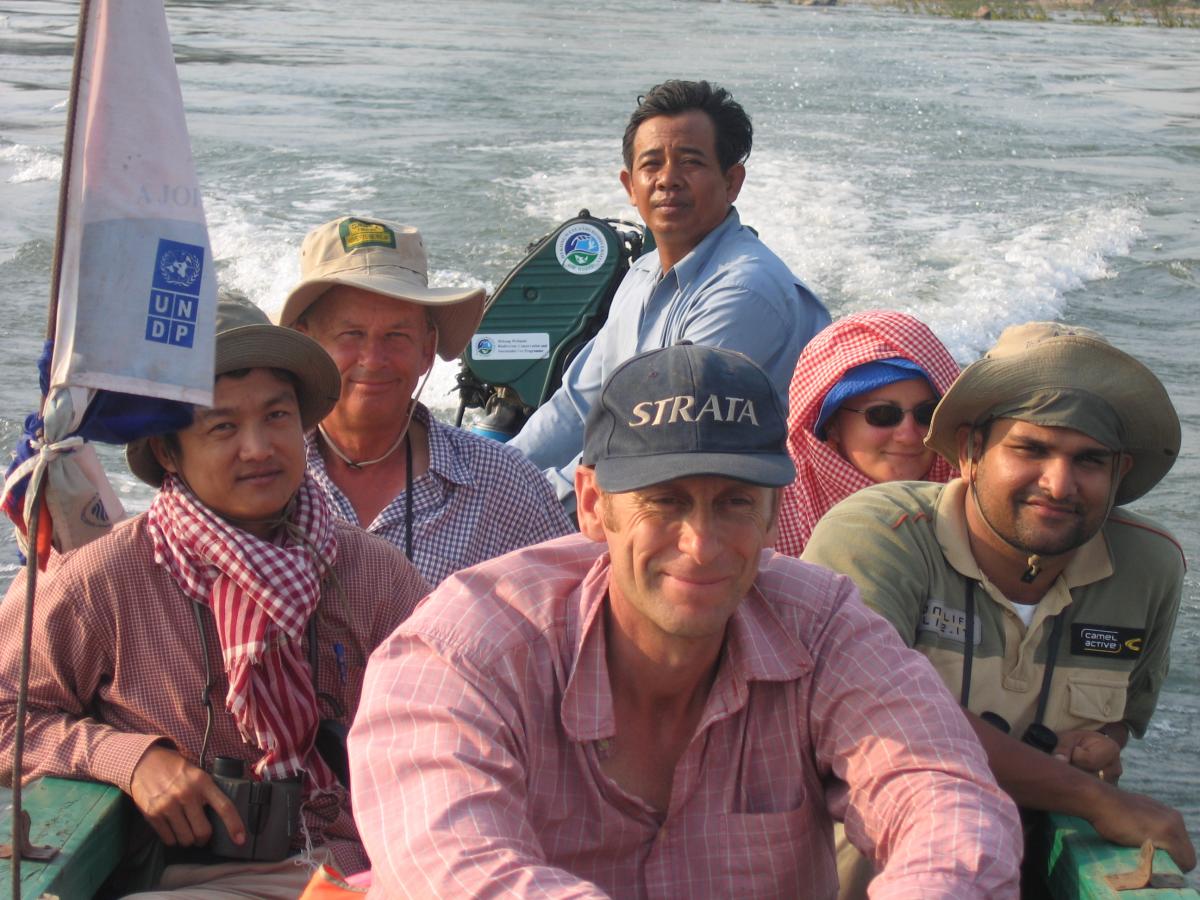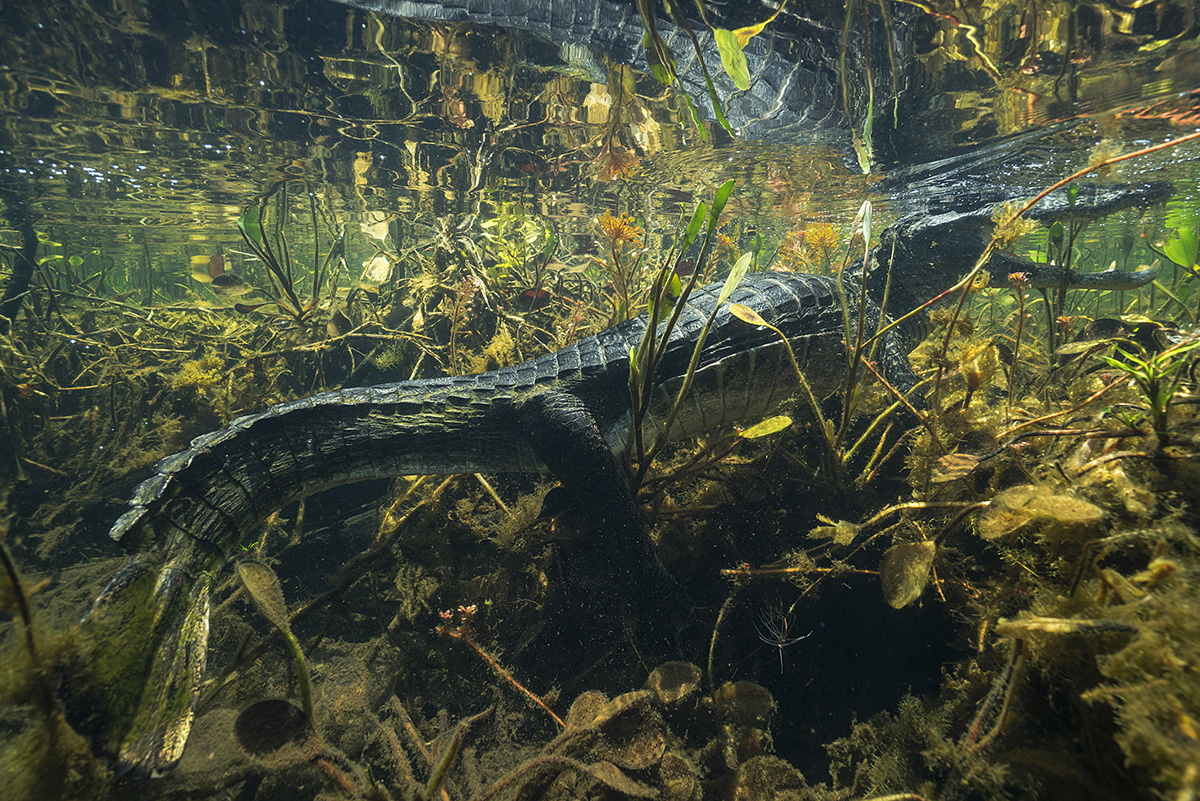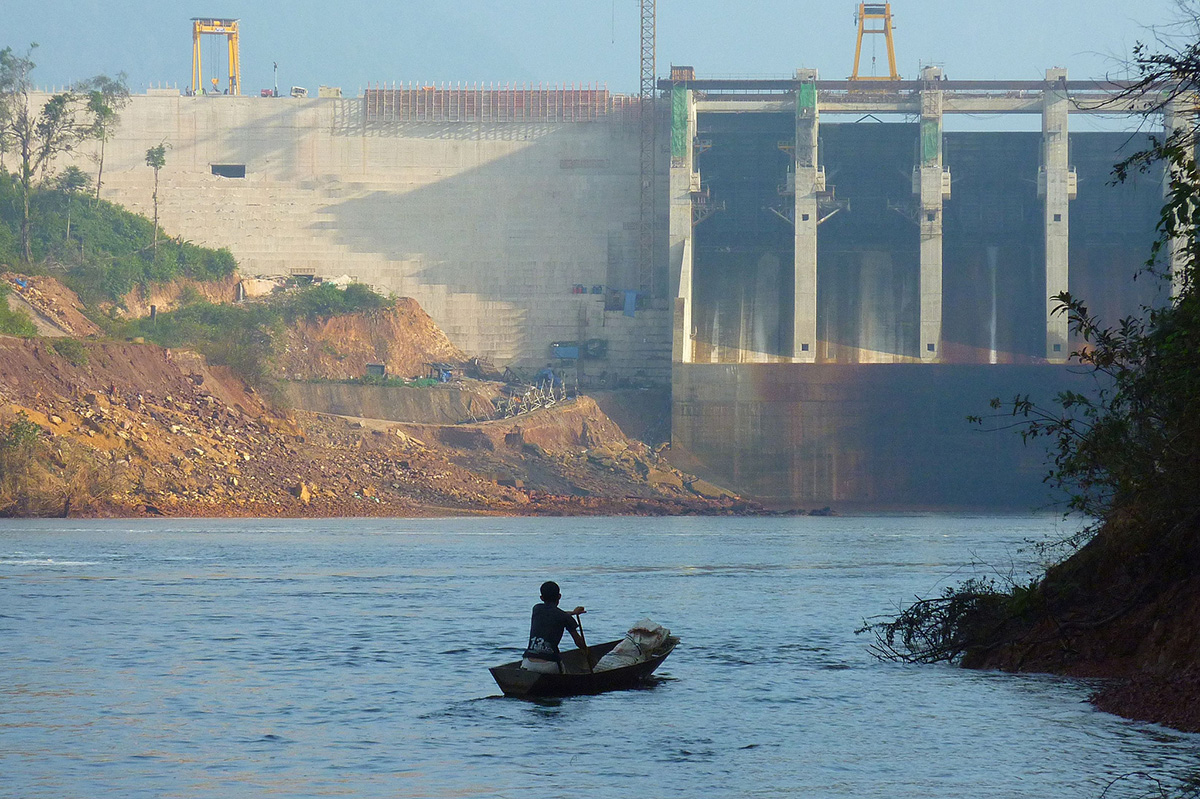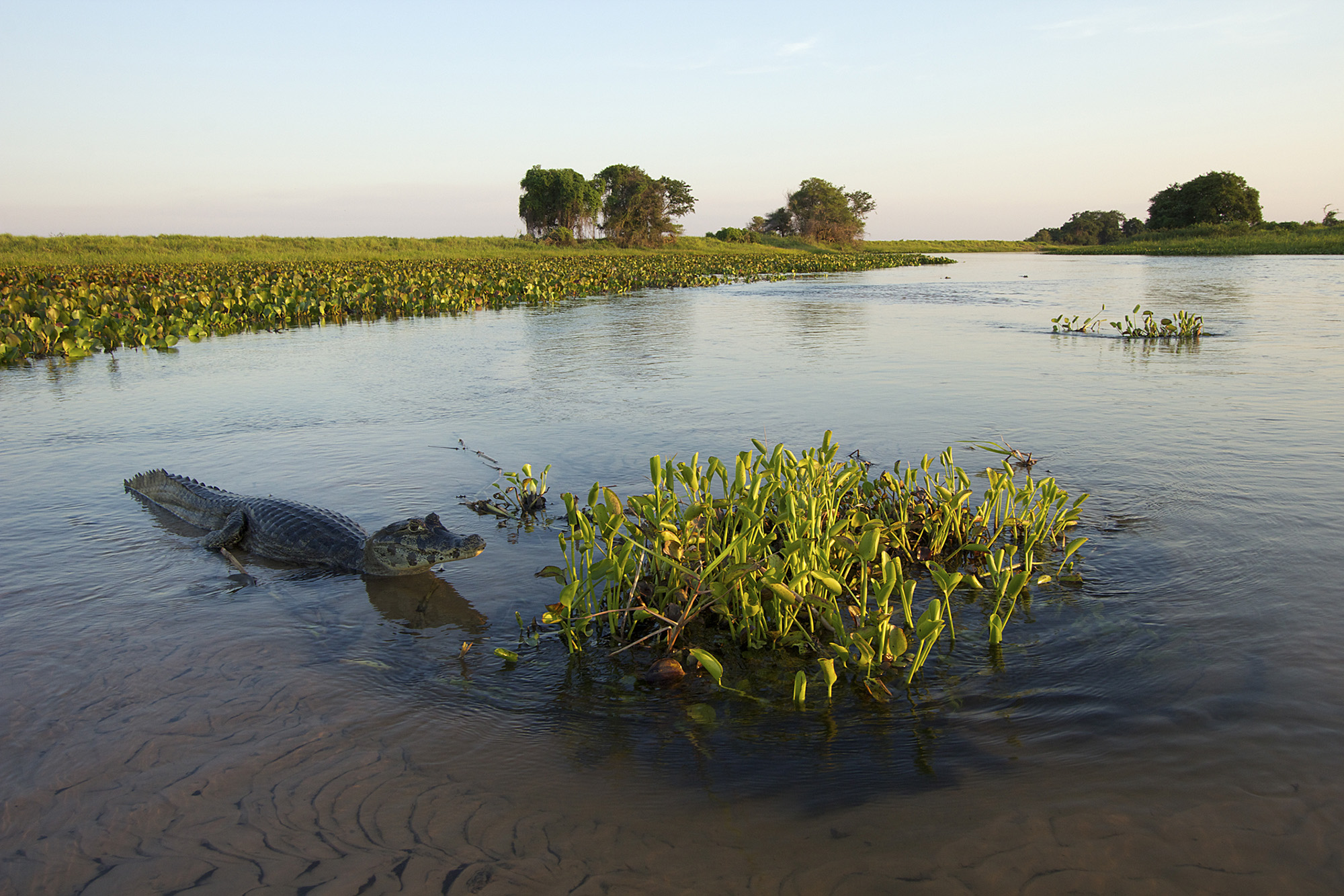Freshwater Conservation : INTERVIEW
Synchronicity Earth - an IUCN Member Organisation - have been supporting the IUCN Freshwater Biodiversity Unit (FBU) since 2013 and have recently published this interview with Dr Will Darwall, Head of FBU Programme. Will talks about the challenges facing freshwater conservationists and his own challenges in the field

Photo: Eddie Allison
Q: How and why did you initially become involved in freshwater conservation?
 Photo: Will Darwall
Photo: Will Darwall
I’ve always been interested in the aquatic side of things. I worked on guppy behaviour for my PhD, but it wasn’t until an opportunity came up to do some work on Lake Tanganyika that I started getting more involved in freshwater conservation. I spent about 6 months there helping to develop an underwater survey programme for species in the lake. I’ve always been interested in these African cichlids, so Lake Tanganyika was an amazing place to spend time. I brought some of the survey methods from marine conservation, and we trained scientists from all four countries which border the lake: first to swim, then to dive and then to do the underwater survey. After that, I got a job on Lake Malawi for a few years, so by then I was already mainly freshwater focused and thoroughly hooked!
Q: Why should people care about freshwater environments and species?
For me, there are three main reasons to care. Firstly, a reason which I think Synchronicity Earth shares with me: we need to care about all species on this planet, not just those that are ‘cute’ and ‘cuddly’.
As a background to that, as far back as 1982, a number of countries signed up to the UN World Charter for Nature, which stated that we should protect all species, regardless of their apparent worth to people – sadly this viewpoint seems to have disappeared in more recent times.
"Freshwater species are not insignificant – around a quarter of the world’s vertebrates live in freshwater, and about half the world’s fish!"
Most people think that there are far more marine fish, but in fact almost half of the world’s fish live in freshwater ecosystems. We need to look after them all.
Secondly, if people took the time to really look closely at what species we have in freshwater ecosystems, they would see that there are some amazing creatures in there. But freshwater species get very little attention, they aren’t in the public eye like other terrestrial and marine species. In some ways, this is a ‘PR’ issue – communicating the wonder and value of these species is just not working very well, so addressing this is very high on the agenda of things we need to do. A great start would be to have a top-level documentary series focusing on freshwater ecosystems.
 Photo: Michel Roggo
Photo: Michel Roggo
Yacare caiman (Caiman yacare), Pantanal, Brazil. Photo: Michel Roggo
The third reason is more pragmatic. Freshwater ecosystems provide us with many benefits, commonly referred to as ‘ecosystem services’. The current focus for government is on provision of these services, and particularly since the financial crisis, is on investing in conservation which has a notable benefit to people. Looking at freshwater, it is not hard to see where these benefits lie. The services provided by functioning freshwater ecosystems are of incredibly high value – one global estimate put their value at around USD 4 trillion a year! From a human perspective, freshwater ecosystems provide us with so much, for example:
- Clean, accessible drinking water: functioning wetlands are very important for water purification and water retention. During dry seasons, if you’ve got wetlands upstream, they retain and slowly release water so that you have a constant supply of water throughout the year. These upper wetlands are sometimes called ‘the world’s water towers’.
- Food: inland fisheries are far more significant than people appreciate. The Food and Agriculture Organisation of the United Nations (FAO) fully admit that their estimates of production from inland fisheries are hugely underestimated – the information simply isn’t being recorded as it is at an artisanal scale. On balance there is likely to be a lot more unreported artisanal fishing than large scale commercial fishing in inland waters. And it’s not just fish that are targeted, it’s shrimps, prawns, crabs and even molluscs: there is a huge industry based on these species in many parts of the world.
- Carbon storage: freshwater ecosystems play a vital role in sequestering carbon. There’s some really good work being done by Wetlands International and others highlighting the value of peatlands which constitute around 50% of the world’s wetlands. The services they provide are huge and not fully realised, certainly within current policy.
- Recreational benefits and human wellbeing: the world’s lakes and rivers also provide excellent recreational opportunities and provide people with a great sense of well-being. Personally I feel great whenever I’m near water, it takes you away from the everyday worries of the world.
Spreading our biodiversity bets
It would be a mistake of course to look solely at the benefits of freshwater ecosystems to human populations, because that can lead to the notion that those species without any apparent benefits to people should be considered redundant and therefore expendable. We really need to push back against this type of thinking. Our environment is currently undergoing huge and rapid change: species that are thriving at the moment may not do so well in the future, while there are other species that we think we might consider expendable and which aren’t very significant or abundant right now which may be the only species that do well in the future.
"Thinking like an investment banker – we need to invest in conserving a broad portfolio of biodiversity for the future."
It’s just like investing in stocks and shares. You don’t just invest in shares that happens to be doing very well at the time, because conditions change. It’s the same for biodiversity, we need to look after it all, spreading our bets to ensure a profitable future for biodiversity.
Q: What are the greatest and most urgent threats to freshwater biodiversity?
Based on the analysis of the work we’ve done for the IUCN Red List – where we look at the specific threats for each species we are assessing – the biggest threat is the loss and degradation of habitat. For example, about 75% of the world’s inland wetlands have been lost, just in the last century.
There are various drivers behind this habitat loss: conversion for agriculture is a major factor. There is also a perception that wetlands are not very useful. They often have a reputation as disease-infested swamps that we’d be better off getting rid of, so they are converted to rice farming or sugarcane, or golf courses, or whatever – people think there are better ways of using the land.
In Europe, where we have spent many years converting wetlands to other uses, we are now spending billions of Euros trying to restore these systems to their former glory! People are finally beginning to understand the value of functioning wetland ecosystems, for example, in flood control. The concern is that in many parts of the world, there won’t be the kind of finance that is needed to restore wetlands once destroyed, so it is vital to avoid initial degradation. This is a challenge, especially if you’re working in developing countries. People see that in Europe or the US we’ve made a lot of money out of “destroying” our wetland systems, but now we’re effectively saying that nobody else should be allowed to do that! What they don’t necessarily see is that we’re now paying a very high price for this destruction.
One of the greatest threats to freshwater ecosystems is of course the global proliferation of dams, often, but not exclusively, for hydropower. Whatever their purpose, dams have a huge impact transforming freshwater ecosystems from rivers into lakes, disrupting downstream water flow, and blocking fish migration routes. There are currently no really good solutions for dealing with fish migration routes being blocked: in most places, fish passes are not particularly effective. Despite all this hydropower is still widely portrayed as green energy, but we know this is often not the case and it should not be portrayed as such.
 Photo: Eric Baran, World Fish (via Flickr)
Photo: Eric Baran, World Fish (via Flickr)
Nam Gnouang Dam, on a tributary of the Nam Theun River in Laos. Photo: Eric Baran, World Fish
Pollution is another huge issue: freshwater ecosystems tend to receive much of what we throw away on land. Our rubbish often ends up at the bottom of the valleys and in the lakes and rivers, as do the pesticides, fertilisers and industrial run-off. There is currently a big focus on plastics in the marine but less so on the source of this plastic waste from the worlds’ rivers.
Another big threat is invasive species. Introducing a non-native species can have catastrophic impacts – yet a lot of species are knowingly, willingly and intentionally introduced all around the world for purposes such as aquaculture which, although it can provide some important local benefits, can also be very problematic where focused on non-native species. There aren’t sufficient controls on the pathways to introduction at the moment and once introduced and established it is most often impossible to remove a species.
Finally, the demand for water is of course a major driver for current and future threats. ‘Water stress’ is becoming an issue in large parts of the world, which means a lot more channelling of water for human use, diverting of rivers, and joining river systems through interbasin transfers. This has a huge impact on biodiversity and it’s a growing problem: as the human population rises so does demand for water and that will continue to have a major impact on freshwater biodiversity.
Q: What exactly is the role of the IUCN Freshwater Biodiversity Unit?
When I started in freshwater conservation, there was almost no coverage of freshwater species on the IUCN Red List of Threatened Species, so we had little information on the distributions or status of freshwater species. Now we have almost 30,000 species categorised on the Red List as requiring freshwater ecosystems, (compared to less than one thousand when we started).
"Our aim is to improve understanding of what the priority freshwater species are and to use that information to identify priority sites where conservation action might be necessary, or where development should be aware and aim to avoid impacts."
We also use the information we gather for systematic conservation planning: by understanding where priority species and sites are, we can propose potential optimal site networks that might be the basis for future protected area networks, or for identifying gaps in current protected area networks. We also do some work on the value of species for livelihoods, and some on climate change vulnerability. All the information is available for others to use, and we hope they will use it to inform their decision making.
The IUCN FBU also tries to ensure that freshwater species are well-represented in the conservation tools that are being developed, such as the IUCN Red List, the Key Biodiversity Areas (KBA) network, policy work and so on. It’s all quite a challenge because freshwater conservation is not foremost in people’s minds, and our work is almost entirely project-funded, so we can sometimes be driven by what the donors would like us to fund. In fact, the funding from Synchronicity Earth has proved to be extremely valuable in that respect, because it has allowed us to be a bit more flexible.
Q: Why do you think freshwater conservation receives far less funding and attention than other types of conservation – tropical forests, oceans etc?
Well, this is something we have been concerned about for a long time and it has been a continuous source of frustration. There is an appallingly low awareness of freshwater biodiversity, generally. Very few people realise what is actually there, how amazing it is and the value it has to people, largely because they can’t see it. There are only a few places in the world where freshwater species are easily seen, like Lake Tanganyika (but few people have been lucky enough to visit this lake), so it doesn’t have the same advantage and profile of coral reefs and tropical forests, which are all much more visible to people.
Donors to conservation projects understandably like to have eye-catching headlines on the work they’ve supported, so this lends itself to stories about highly charismatic species such as tigers or pandas and so on. These species make great headlines and the pictures are impressive, so the supporters of those donor organisations get the profile they need to show where their money is going, which is obviously very useful. But it’s difficult to do that for freshwater species – or at least more difficult – as they are not noted for their beauty and charisma.
 Photo: Michel Roggo
Photo: Michel Roggo
 Photo: Michel Roggo
Photo: Michel Roggo
The world's largest wetland and a Yacare caiman, Pantanal, Brazil. Photo: Michel Roggo
Q: Aside from this lack of funding and attention, what are the biggest barriers to successful freshwater conservation?
I think the biggest issue is that most policies for management of freshwater systems are almost entirely focused on the management of water as a resource for people, with little if any regard for the other species living in it. While understandable, this approach is very short term. Unless we maintain the environment, the forests and the wetlands, then our water cycle will be disrupted and in the long run we just won’t have the water supply we need.
At the moment, very little attention is given to ensuring that the water regime within wetlands is sufficient to maintain a functioning wetland ecosystem. In most cases, the work involved is focused on the governance of water for use by people, as drinking water, for urban use or industrial use: there’s not enough time being devoted to ensuring that there is sufficient water left in the system for the ecosystems.
Work has been conducted looking at the impacts of deforestation in the Amazon and the links between this and major droughts on other continents. People are gradually starting to make the connections and it is becoming clear that we have to look at the system level. The fact that we don’t fully understand these links is why the precautionary principle should always be applied – don’t mess things up too badly before you understand what’s going on! As long as the approach is that it doesn’t matter what happens to the ecosystem as long as there’s a water supply coming through for people, that is a disaster for long-term water management and for freshwater biodiversity.
Q: In your career in freshwater conservation so far, can you give an example of a high and a low point?
From a personal point of view, a high point has to be the time I spent working in Lake Tanganyika. The lake is incredible, it’s crystal clear, and just standing in the shallows when I arrived there, I saw almost all of the species I had ever seen in my aquarium, swimming around my feet!
The ecosystem there is so diverse – you’ve got the tropical forests coming down to the shore, with their chimpanzees and other animals, and then the water of the lake itself, which is crystal clear, and you get these amazing drop-offs – fun to dive on. Because the lake is very high in calcium carbonate, the rubble and rocks in the shallow waters have welded together forming a very similar habitat to a coral reef where you can see all the different ecological niches occupied – it’s beautifully diverse.
Most of the fish species in the lake are endemic, being only found in this one lake, you’ve got endemic molluscs – the shells – which look like marine species (actually a lot of people thought the lake must have once been connected to a marine environment, because these shells are so diverse and beautiful). You’ve got endemic jelly fishes, a water cobra that is deadly, but not aggressive, one of which used to swim between us when we were doing the dive training! Lake Tanganyika is just an incredible place – when we consider what we want to keep for the future – this is the kind of place that will really inspire people.
Q: And the low point?
Back in 2010, we did an assessment of the world’s sturgeons for the IUCN Red List. It was an epic low point to discover that, of the 27 species of sturgeon, 85% of them are threatened with extinction, with 17 of them Critically Endangered. I think that is the worst status of any taxonomic group. And if you look at data recorded since, the catch records and so on, they are still plummeting. These species include some of the largest freshwater fish in the world, they’ve been around since the dinosaurs, are one of the oldest groups of fish, and the way things are going, in our lifetimes and on our watch, almost entirely due to our actions, we’re pushing them into extinction.
Several species of sturgeon are already presumed extinct. For example, the Chinese paddlefish (Psephurus gladius), is now thought to be extinct and was possibly the longest fish found in freshwater. Yet hardly anybody has even heard of it – and it certainly didn’t make the headlines! If that was the panda or some other species it would be very different. If we cannot even look after these enormous and amazing fish, then it makes you wonder what hope is there for the other less impressive species?
Q: Despite all the evidence showing the vital role freshwater ecosystems and species play, this message doesn’t seem to be filtering through fast enough into changes in policy and practice. Why do you think this is?
For me the biggest issue with getting freshwater biodiversity influencing policy is that those working to protect it have no voice. Even if we have the best data – we have the facts, the level of loss of wetlands, threats to species, declining populations – unless we have a large enough group of people providing the voice for freshwater biodiversity at the policy level, the message won’t get through. Currently, the community of freshwater biodiversity conservationists is small – it is very difficult to get a critical mass of people to attend events, conferences and so on to work together to have more of an impact.
"We need a global network of freshwater biodiversity experts with funding to attend and contribute to these important events."
Better communication and awareness-raising has to drive everything, like it has been doing with ocean plastics recently. Unless the public care, we’re not going to make the politicians care, because the politicians respond to voters. Until the public see a need to focus on this, it is much harder to drive policy change. We need to get some really high level documentaries made – a Blue Planet for freshwater if you like – and find high profile champions of freshwater diversity. We’ve been saying this for a long time, but it requires funding and is certainly not easy.
Q: Can you give us some examples of where policy and practice have come together for the benefit of freshwater ecosystems?
One approach being promoted now, which I think has huge potential to influence policy, is the recognition of natural infrastructure, which means recognising and utilising the ecosystem itself for the services that you need (whereas grey infrastructure would be structures such as dams, pipelines etc). The most obvious example is for water purification: instead of building an expensive water purification plant, you can, in some cases, instead properly maintain the wetlands which also purify the water but at a fraction of the cost. Another example would be the Catskill Mountains in New York where, by maintaining the forested upper catchment, they maintain an excellent water supply, with barely any need for purification. The approach requires letting natural systems do what you would otherwise have to build some expensive grey structure to do, having probably destroyed the natural infrastructure in the process.
There are some great examples involving various different stakeholders in natural infrastructure projects. For example, near where I live in the southwest of England, the local water company provides money to restore upstream peatlands because they understand that it results in better quality water coming out the other end, which saves them a lot of money. By restoring the peatlands you really improve the biodiversity and improve the quality of water flowing in the rivers which also benefits biodiversity downstream. So it’s a win-win situation: you’ve got the private sector and conservation sector working together, while government and everyone else benefits. The water company can of course also rightly claim that they’re not just doing this for their own benefit – what they’re doing is having huge biodiversity benefits all round, which is good for their corporate profile.
Q: What role do you think Synchronicity Earth has played/can play in strengthening freshwater conservation initiatives?
Up to now, the thing that has really struck me as the major role played by Synchronicity Earth, particularly for us at the IUCN Freshwater Biodiversity Unit, is the way they have been able to provide long-term flexible funding support. This really is gold dust for us, because it doesn’t exist anywhere else as far as I can see.
As with a lot of smaller organisations, being entirely dependent on project funding, you tend to be driven by the donor and where they want to fund. Having the flexibility provided by Synchronicity Earth to choose where we develop projects has been of huge benefit to us.
"In future, I think, Synchronicity Earth can also play an important role in helping to raise the profile of freshwater biodiversity and conservation. This is absolutely key, and without it I think we’re a bit stuck."
Why would people care about something they know nothing about and if they don’t see any value in it? For people living their day to day lives, it’s probably not going to be very high on the agenda.
The other area I think where Synchronicity Earth really contributes is in helping to source new funds. Synchronicity Earth focuses on trying to bring in new funds, rather than competing for existing sources, which becomes highly unconstructive. Within the conservation world it becomes very competitive when there’s not enough funding: people don’t talk to each other and they duplicate work, rather than collaborating which would be far more constructive. So, Synchronity Earth please keep up the great work in bringing new funding to the massively underfunded world of freshwater species.
